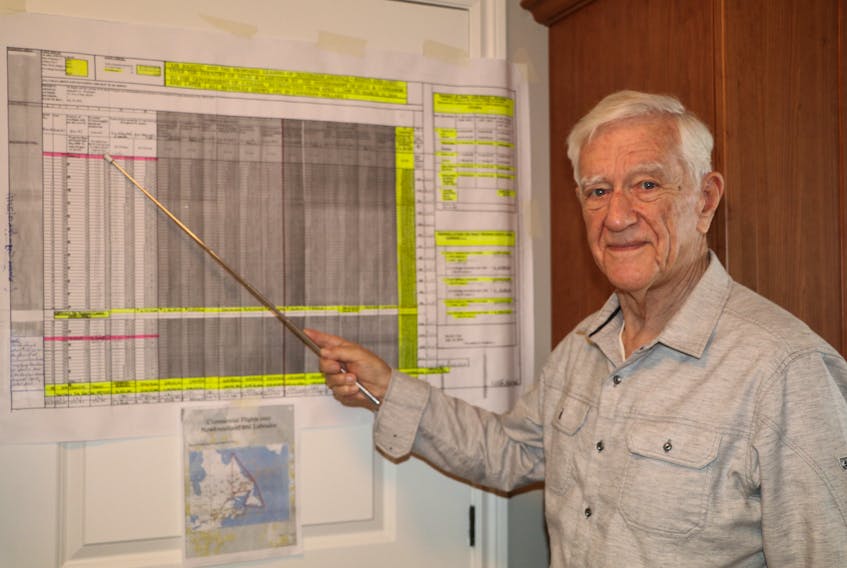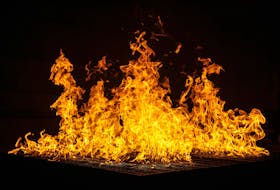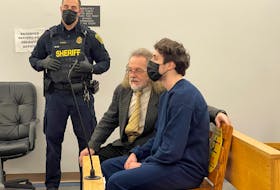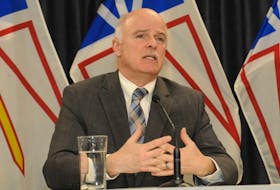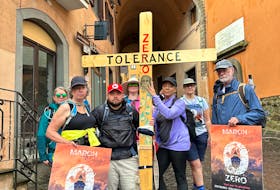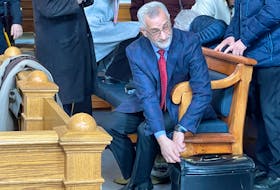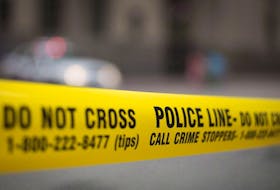Newfoundland and Labrador is the sole owner of its airspace and therefore millions of dollars in revenues collected for its use each year by the federal government should come back to the province — or at least a fair percentage of it, says retired engineer David Fox.
And, he said, the province should be paid retroactively to 1949.
His research shows that the amount, including interest since Confederation, adds up to about $9.85 billion. Even if the provincial government got half of that — split it 50/50 with the federal government, which maintains the country’s airport system, he noted — it would go a long way to help solve the province’s current dire fiscal situation.
Fox says Newfoundland and Labrador’s airspace was not among the assets transferred to Canada under the 1949 Terms of Union.
Thus, he said, since Confederation, the bill has been adding up and the provincial government should make efforts to collect.
“By virtue of this non-transferred sole ownership, Newfoundland and Labrador should have received revenue generated from its airspace, a revenue which since 1949 approaches $9.85 billion,” Fox said. “In light of this province’s present financial situation, the provincial government should investigate these circumstances and possible revenues from the province’s airspace, as Newfoundland and Labrador is owed billions retroactively, and hundreds of millions annually.”
Fox has been researching the issue for the past 20 years.
In his St. John’s home, he has piles of documents, books and charts. Some of the documents and charts he has created with numbers and information are taped to an area of the wall for display, and even on the outside of the door to his bathroom.
He points to his charts with a pointer while presenting his research.
Fox grew up in St. John’s. He has worked as an engineer in both Newfoundland and Labrador and Nova Scotia, and was also the port manager and CEO of the St. John’s Port Authority from 1980 until his retirement in 1998.
His passion for Newfoundland and Labrador comes not only from being a resident, but from his family’s history. He is the son of Mary (nee Cashin) Fox and Cyril J. Fox — a Superior Court justice and the first chairman of the National Convention.
David Fox’s grandfather was Sir Michael Cashin, and his uncle was Maj. Peter Cashin — both prominent names in the history of Newfoundland and Labrador. Peter Cashin was an anti-confederate who favoured a return to responsible government.
Fox said he got the idea of looking into the airspace issue one day when he was working with the port authority and was watching aircraft passing overhead. One of the big items of priority for him at the time was making sure users of the harbour paid their fees.
“I had read some things on airspace and sovereignty of airspace,” he said. “Airspace is an asset to a country. Ireland, for instance, relies heavily on airspace revenues.”
Fox noted that in 1944, as a British dominion with suspended status, Newfoundland representatives attended the Convention on International Civil Aviation in Chicago. The Newfoundland representatives were part of the United Kingdom delegation.
Documents show that Sir George London and Sir Albert Joseph Walsh were the Newfoundland delegates.
“The agreement signed at this meeting on Dec. 7, 1944, established the International Civil Aviation Organization, the international rules for all future commercial aircraft registration and safety, and the rights of air travellers,” Fox said.
“Fifty-two signatory states ratified the original Chicago Convention. Under this Chicago Air Convention of 1944, Newfoundland (through the United Kingdom) retained sole sovereign ownership of its airspace.”
The Chicago Convention would lead to the Provisional International Civil Aviation Organization (PICAO), which was agreed to be headquartered in Montreal in 1945 as the permanent seat of the International Civil Aviation Organization.
In Volume 2 of The Newfoundland National Convention (1946-1948) reports and papers, edited by J.K. Hiller and M.F. Harrington, there’s a debate when members of the National Convention — including Joseph R. Smallwood, Maj. Peter Cashin and Chesley A. Crosbie — question J.S. Neill (commissioner of public utilities under Commission of Government) about operation of the Gander Airport and about PICAO. Newfoundland had agreed to take over the operation of the airport after the Second World War.
Crosbie: “This PICAO — this body which controls rules and regulation — they deal only with air rights for air rights.
Neill: “PICAO is largely technical, (produces booklet).”
Crosbie: “We are not a member of PICAO?”
Neill: “Yes. The United Kingdom is. They sign for us.”
Smallwood: “Newfoundland has no part, except as part of the United Kingdom.”
Crosbie: “Whatever the United Kingdom says, goes, as far as Newfoundland is concerned?”
Neill: “That is not correct.”
Cashin: “If we had been fortunate, or unfortunate enough to have our own government, they would never have agreed to that.”
Smallwood: “In what capacity, exactly, did the Newfoundland representatives attend any meetings of PICAO?”
Neill: “They attended as part of the British delegation.”
Fox states that the airspace territory of Newfoundland and Labrador encompasses 405,319 square kilometres. He said from his research an average of 1,260 aircraft pass through this airspace daily.
In 2016-17, he said, the federal government collected $1.29 billion in gross revenues from overall Canadian airspace — $400 million of it from aircraft passing through the airspace over Newfoundland and Labrador.
“Term 33 of the 1949 Terms of Union itemized the exact public works and property of Newfoundland which, upon Confederation, would become the property of Canada,” Fox noted. “Term 35 stated that, ‘Newfoundland public works and property not transferred to Canada by or under these terms will remain the property of the province of Newfoundland and Labrador.’”
Fox said that when the United Kingdom signed the document at the Chicago Convention, Newfoundland was its own country, with its own airspace and sovereignty. He said the airspace has remained a Newfoundland and Labrador asset since Confederation.
Fox has numbers charted for each year since Confederation, including how many aircraft have flown through Newfoundland and Labrador airspace each year, the revenue collected and interest on it, and what Newfoundland and Labrador is owed. He has even calculated for the extra days of leap years.
“These are rough numbers, but they are in the ballpark,” Fox said, pointing to his chart. “It’s right there in front of us. It’s not in the Terms of Union and that’s the bible. The province and the federal government might not want to open this up, but I think I’m right on this.”

